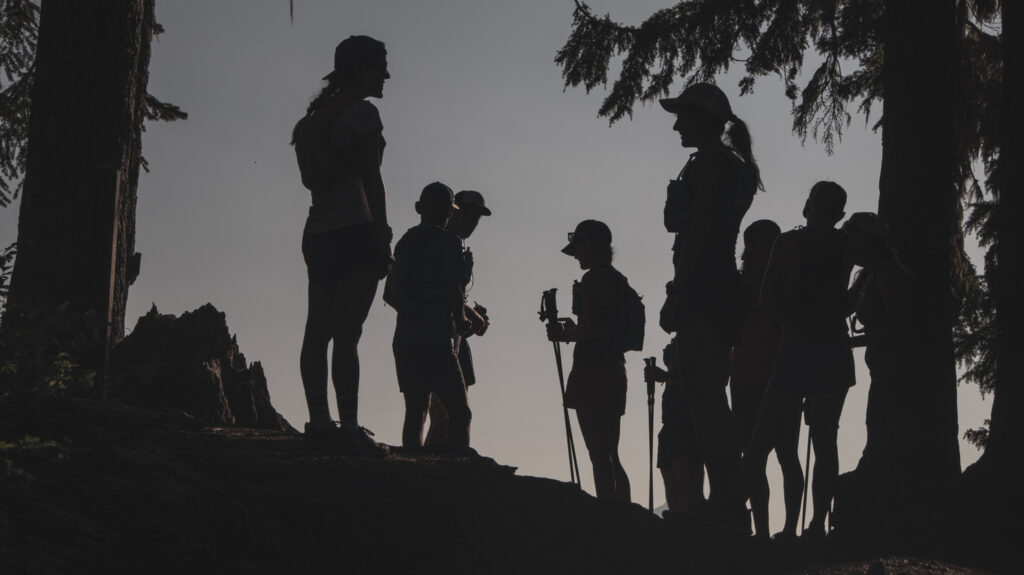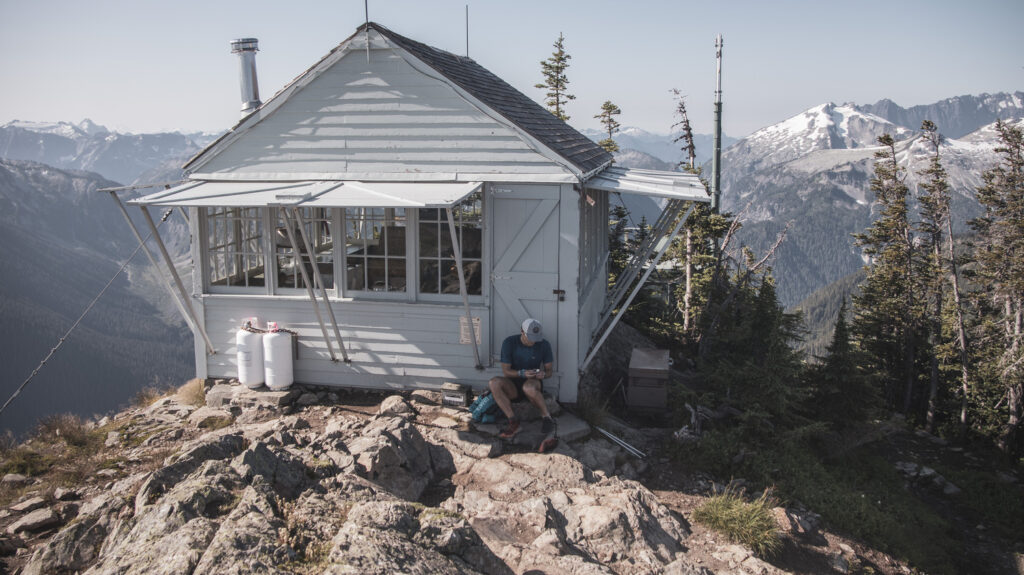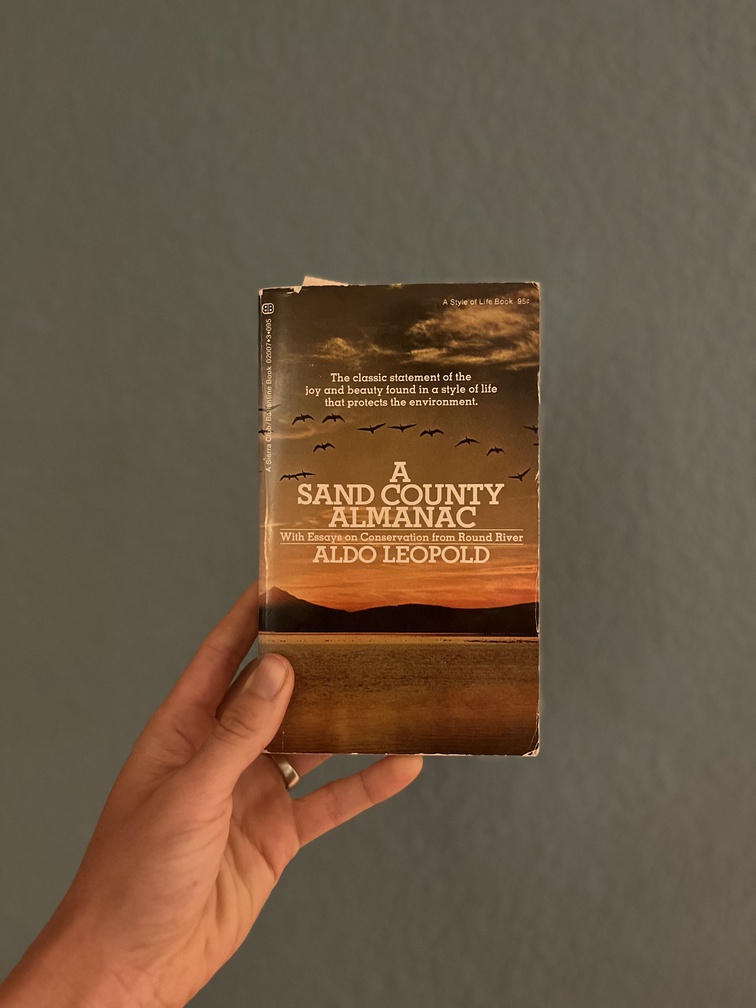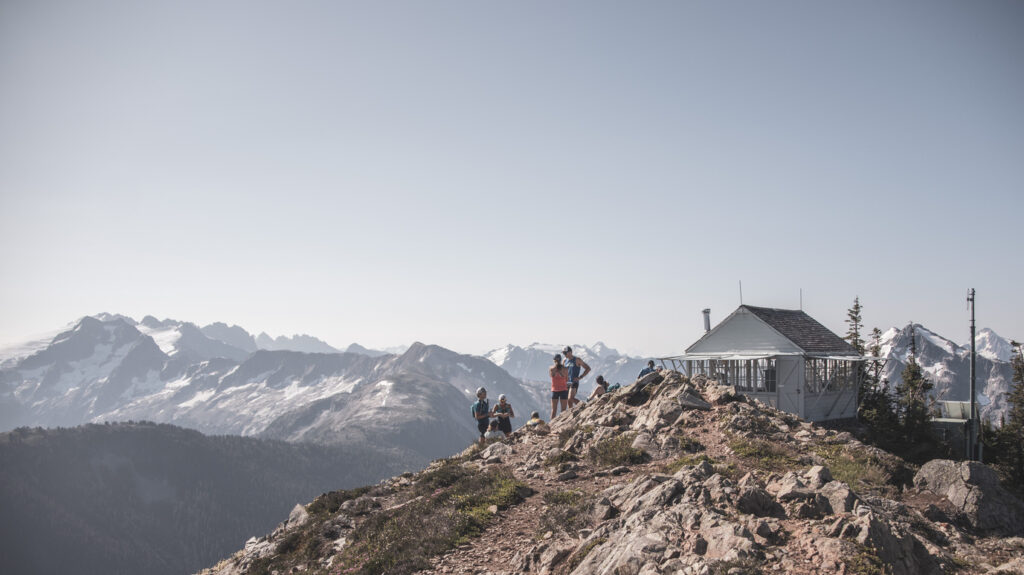A List of Environmentally Friendly Books for Any Runner
As trail runners and athletes, most of our time is spent on the trail, preparing for long runs, hitting our workouts, or participating in races. In between all that movement, we can sometimes find stillness. Whether it’s recovering from our latest ultra-marathon, traveling to a trail race on the other side of the world, or taking the night off after a hard training session, we’ve got plenty of time to get comfortable in bed, snuggle up with a warm cup of tea (or a beer, we don’t judge), and settle into a good book.
If you’re like me, choosing your next read can often be overwhelming because there are many options. Maybe even too many options. But if you want to reconnect with the natural world, learn more about our changing planet, or dive deep into the world of climate activism, we’ve compiled a list of recommendations for any eco-curious runner.

TIER 1 – The Hard Facts
Let’s start with books that focus on the hard facts and information, whether that’s documenting the rapidly changing climate or diving deep into the intricacies of soil health; these books are perfect for anyone looking to learn more about the natural world.
Field Notes from a Catastrophe by Elizabeth Kolbert
For the past decade, Elizabeth Kolbert has been one of the more prominent journalists writing on the climate crisis. Since 1999, she’s been working as a staff writer for the New Yorker and has written several books on climate change, including her bestsellers The Sixth Extinction and Under the White Sky. All of Kolbert’s writing could’ve made this list because they all offer important insight into climate change and activism. However, her first book, Field Notes from a Catastrophe, still stands as one of the first in-depth introductions to climate change science and research.
Throughout Field Notes from a Catastrophe, Kolbert travels around the world to uncover different issues caused by the changing climate, including rising sea levels, rapidly thawing permafrost layers, and diminishing ice shelves. The book provides expert interviews, groundbreaking scientific information, and alarming facts and figures, painting one of the first complete pictures of our rapidly changing planet.
For myself, I read the book in my freshman year of college, and it completely shifted my perspective on the climate crisis. In many ways, Kolbert’s book is still one of the primary reasons I pursued a career in environmental journalism, wildlife conservation, and climate storytelling.
This Changes Everything: Capitalism vs The Climate by Naomi Klein
Naomi Klein has been one of the more powerful, and controversial, voices on climate change and environmentalism in the past few decades. In This Changes Everything, Klein takes a scathing and compelling shot at the economic structure of our planet and the impacts of runaway capitalism. She argues that the state of our climate is a consequence of organizations and economic systems designed to proliferate climate change by exploiting resources for profits. Her bookl is an enticing and thought-provoking commentary on the ways our systems influence the planet and provides a deeper understanding of the field of environmental economics.
The book debuted on the best-seller list and was met with much criticism and controversy because of its stark anti-capitalist rhetoric and theories, solidifying it as one of the most contentious environmental books since Rachel Carson’s Silent Spring.
Kiss The Ground: How the Food You Eat Can Heal Your Body, Reverse Climate Change, and Ultimately Save the World by Josh Tickell
As runners and athletes, we think a lot about our food, nutrition, and the things we put into our bodies. As it turns out, these food choices have major connections to our global climate and environmental systems.
In Josh Tickell’s Kiss the Ground, he explores the connection between our food choices, climate change, and soil health. The book is a fascinating deep dive into the American agriculture industry and how our farming practices have influenced the planet’s well-being. Throughout the book, Tickell meets with several agricultural workers, farmers, and scientists to discuss the impacts of our farming systems on the climate. The book also focuses on the many solutions in the field, offering hope through the work of farmers and scientists, highlighting our ability to protect the future of our planet.
Note – There is now a feature-length documentary based on the book streaming on Netflix.
The Intersectional Environmentalist: How to Dismantle Systems of Oppression to Protect People + Planet by Leah Thomas
In 2020, in the wake of the murder of George Floyd, Leah Thomas called upon environmental activists to support the Black Lives Matter movement, coining the term “intersectional environmentalism.” Thomas coined the phrase as a means of explaining the “inextricable link” between environmentalism, racism, and privilege.
Her debut book, The Intersectional Environmentalist, dives deeper into this link and highlights how environmental injustices affect people, specifically marginalized communities. Through the book, Thomas pushes for the environmental fields to focus more on issues of injustice, poverty, racism, and sexism to help support efforts to protect and conserve our natural systems.
The Intersectional Environmentalist is a mind-opening commentary on environmental justice and establishes the foundation for a more progressive and holistic conservation movement that prioritizes social justice and equality. This book is a fascinating look at the necessary future of environmentalism in the 21st century while examining the many ways our society is tied to the natural world.

TIER 2 – Reconnecting
As outdoor recreationists, we know you love a good walk through the woods or wide open landscape. That’s why this next tier is all about reconnecting with the natural world and the many feelings and emotions behind this connection.
Nature by Ralph Waldo Emerson & Walden by Henry David Thoreau
In the mid-1800s, Ralph Waldo Emerson and Henry David Thoreau were two of the foremost writers on philosophy and the environment. These two writers and philosophers were friends and original members of the transcendentalist movement, which played a major role in changing the American view of nature and provided the foundations for the next century’s efforts to protect the environment.
Their two highly-acclaimed essays, Emerson’s Nature and Thoreau’s Walden, were two of the first significant works to advocate for the protection of wilderness because of its inherent value and beauty instead of its usefulness as a resource.
In Nature, Emerson establishes the foundation for transcendentalism, arguing that we can better understand reality by studying the natural world and its divine existence. In Walden, Thoreau documents his existence, living in a cabin near Walden Pond over a two-year period. Through his literary work, he puts forth ideas of transcendentalism, including the inherent value of nature, while documenting the many surrounding plants and animals, using them to make both practical and spiritual metaphors for life.
Braiding Sweetgrass: Indigenous Wisdom, Scientific Knowledge, and the Teachings of Plants by Robin Wall Kimmerer
In Robin Wall Kimmerer’s fascinating book, she shares her journey to rediscover the importance of indigenous knowledge and grow her understanding of the inherent connection between humans and the land. As a member of the Potawatomi people, Kimmerer recounts her experiences learning about her people’s historical and cultural traditions while working as a botanist.
The groundbreaking book is widely celebrated for its ability to illustrate the spiritual and emotional connection between humans and the natural world. Her experiences are retold in a way that showcases the intuition of indigenous practices and provides a newfound perspective for the plants and animals around us. Told through Kimmerer’s essays, the book is deeply personal, helping readers redefine their own experiences with the environment and develop a more profound connection with the natural world.
Desert Solitaire by Edward Abbey
Okay, let’s be honest first: Edward Abbey isn’t for everyone. His views on certain topics are the subject of much controversy, and he could be a bit, shall we say, much. Still, his writings are some of the most intimate portraits of the American West, and his writings are interesting and thought-provoking commentaries on public lands in the United States.
In Desert Solitaire, Abbey recounts his time working as a park ranger for Canyonlands National Park in the 1950s. The book is a compilation of Abbey’s notes and journal entries from his time at the national park in Southeastern Utah. Throughout the book, he explores his feelings toward the wilderness, the beauty of nature, and his musings on development and tourism. The book is full of Abbey’s adventures, from backpacking around the high desert to a tenure helping the park’s search and rescue team.
In many ways, Desert Solitaire is a love letter to the desert landscapes of the West and the beauty of these wide open spaces. It’s also one of the original written works of environmentalism in modern American history.
A Sand County Almanac by Aldo Leopold
One of the most acclaimed and celebrated environmental novels of the 20th century, Sand County Almanac is a vivid description of nature and the environment in the Midwest. The book is a collection of Leopold’s personal essays documenting his feelings of connection to the natural world around him. The book also postulated the idea of “land ethic,” which introduced the idea of humans having a responsibility to tend and conserve the land around them.
As the “Father of Wildlife Management,” Leopold’s work is one of the founding works on the way our country and society manages our public lands, wildlife, and nature. It’s such a prominent work that during my undergraduate degree in wildlife biology, this collection was a required reading for all students.

TIER 3 – Finding Adventure
As trail runners, we know you are always up for a little adventure and type two fun. These next three books include stories about individuals and communities that blend a love for adventure with a desire to study and understand the natural world.
The Sun Is a Compass by Caroline Van Hemert
The Sun is A Compass follows the story of Caroline Van Hemert and her husband as they trek from Bellingham, Washington, to the Alaskan Arctic. The book encapsulates their entire journey through the wilderness using only human-powered means of travel, including kayaks, cross-country skiing, and hiking.
The book is an enticing look at an ornithologist’s efforts to reconnect with her wonder for the natural world, something she feels she has lost through the pains and monotony of life in society. Throughout the book, Van Hemert documents her growing reconnection with the wilderness and her renewed passion for her work studying birds. The book is a beautiful ode to the power of the outdoors and its ability to help us rediscover our purpose, reconnect with nature, and find our own journey in life.
The Snow Leopard by Peter Matthiessen
The Snow Leopard is a highly acclaimed story about field biology, following the two-month expedition of George Schaller and Peter Matthiessen to locate Snow Leopards in the Dolpo regions of the Himalayas. The book is an encapsulating and breathtaking account of life in the alpine regions of one of the planet’s most notorious and revered mountain ranges.
Matthiessen’s efforts to describe the expedition throughout the novel are unmatched, and his descriptive writing paints incredible images of daily life throughout the trek. The novel also showcases the magnitude of effort, expertise, and adventure that is needed to study animals in their natural habitat. It’s also a beautiful commentary on the diversity of life and its ability to survive in extreme circumstances, highlighted through the mystery and mystique of one of Earth’s rarest creatures.
Spirit Run: A 6,000 Mile Marathon Through North America’s Stolen Land by Noé Álvarez
You didn’t think we would get through this list without a book about actually running, did you? Noé Álvarez’s autobiographical book follows his experience joining the Peace and Dignity Journeys, a four-month run from Canada to Guatemala. As the son of Mexican immigrants, Álvarez joins the Native American (First Nations) movement to reconnect with his heritage by learning from the land and the Indigenous wisdom of the journeys.
The book is a beautiful and emotional tale about the adversity faced by first-generation Americans. It’s also a thought-provoking story that highlights the stories of different indigenous runners who, similar to his own efforts, are trying to reestablish a connection to their ancestral lands and celebrate their heritage. Throughout Álvarez’s journey, he encounters many different runners, all pushing their limits by traversing hundreds of miles across different landscapes, reconnecting with local communities, and forming new relationships with the practice of running. It’s a powerful book that will make any runner rethink their relationship with their practice and give a newfound appreciation for the land and its ancestral stewards.

Tier 4 – Fiction
Although conservation and environmentalism are based in the real world, sometimes it’s nice to escape reality and reconnect with the planet through fictional stories. That’s why our last tier is comprised of two of our favorite environmental non-fiction stories of a world slightly different from our own.
The Monkey Wrench Gang by Edward Abbey
Another of Abbey’s famous works, The Monkey Wrench Gang, follows four individuals from the American Southwest in their efforts to dismantle development projects across the western United States. The book closely echoes Abbey’s anger and frustration found in Desert Solitaire, told in a captivating fictional account of four friends who find themselves using eco-terrorism to wreak havoc on the American industrial machine.
The book is an incredibly nuanced portrait of a period in history when the environmental movement was growing in prominence across the world. The Monkey Wrench Gang is a consequence of this growing anger, providing a voice for the frustration and resentment felt by many toward the increasing development and destruction of nature across the country in the 1970s.
Interestingly, Abbey’s fictional novel holds a lot of modern-day importance, and many of the feelings in the novel are present in the growing climate activism movement. Similar to the ways the book’s titular characters, Seldom Seen Smith and his compatriots, cause mischief to advocate for nature, we’ve seen many climate activists take on similar tactics to call for organizations and governments to increase their efforts to mitigate climate change.
Honestly, The Monkey Wrench Gang is a fun and wild ride and pairs well with any desert ultramarathon or cross-country road trip.

The Overstory by Richard Powers
In a similar context to The Monkey Wrench Gang, Richard Power’s award-winning novel, The Overstory, follows the lives of eight strangers whose life circumstances cause them to become involved with the protection of trees.
Power’s massively successful novel is divided into four sections, “Roots,” “Trunk,” “Crown,” and “Seeds.” In each section, the book follows the different lives of the eight strangers, becoming even more intertwined with the protection of trees, and in turn, with each other. It’s masterful storytelling, turning the chaos of each narrative into a single dramatic story, all intertwined with a natural connection.
The book is also a beautiful commentary on the many ways we are inexplicably linked to both nature and one another. Each of the stories teaches about the many ways the natural world informs our lives and implores us to learn from the teachings of these magnificent organisms. It is both a thrilling novel about life but also an ode to the many ways we are drawn closer together by something we truly share with one another – nature.
If you’re a Freetrail Pro member head on over to Slack and in the articles channel let us know if you’d be interested in joining a Freetrail book club in 2024. Environmental or otherwise our reading list is growing!
